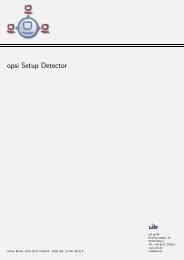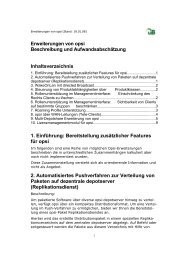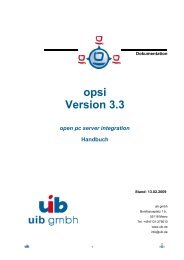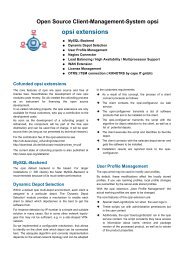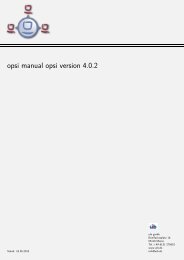opsi Version 3.3.1 - opsi Download - uib
opsi Version 3.3.1 - opsi Download - uib
opsi Version 3.3.1 - opsi Download - uib
You also want an ePaper? Increase the reach of your titles
YUMPU automatically turns print PDFs into web optimized ePapers that Google loves.
6. <strong>opsi</strong>-Module: depot server<br />
The other configuration data is located in the file '/etc/dhcp3/dhcpd.conf'. This file can<br />
be edited (in addition to the common unix/linux editors) web based with the gui-tool<br />
webmin(web based interface for system administration for Unix ).<br />
Basically there are three ways of IP address allocation on DHCP-Servers:<br />
Dynamically: From within a certain range of IP addresses vacant addresses are<br />
assigned to a client for a certain amount of time. At expiration – even during a<br />
working-session – the client has to try to extend this assignment, but eventually<br />
the client gets a new IP address. In this way the same IP address can be used at<br />
different times by different clients.<br />
Automatically: An unused IP address is assigned to each client automatically for<br />
an unlimited time.<br />
Manually: The assignment of the IP addresses is configured by the system<br />
administrators manually. At a DHCP-request this address is assigned to the<br />
client. For the <strong>opsi</strong> depot server this method is recommended, since this<br />
simplifies the network administration.<br />
PCs with a static IP address can use both protocols DHCP/PXE or BOOTP (depends on<br />
the network controller's bootprom).<br />
A dynamic or automatic IP address assignment can only be realized with DHCP and<br />
PXE bootproms.<br />
BOOTP (Bootstrap Protocol) only supports static assignment of MAC and IP<br />
addresses, like the manual assignment with DHCP.<br />
There are only 2 types of data packets with BOOTP: BOOTREQUEST (Client-<br />
Broadcast to Server = request for IP address and boot parameters to a server ) and<br />
BOOTREPLY (Server to Client: advise of IP address and boot parameters).<br />
At the start of the network connection the only information a network controller has got<br />
is its own hardware address (= hardware ethernet, MAC of the NIC), consisting of six<br />
two-digit hexadecimal numbers.<br />
98



